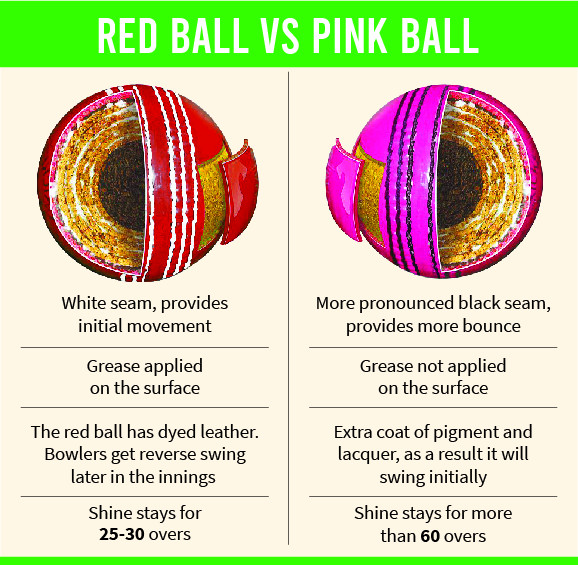Pink Ball Cricket | 23 Nov 2019
India is currently playing its first pink-ball, day-night Test match against Bangladesh at Eden Gardens (Kolkata). The match started on November 22, 2019.
- For this match the pink ball has been manufactured by Sanspareil Greenlands (SG), a Meerut-based sports company.
Day-night Test
- A day-night Test match is played either totally, or partially under floodlights (artificial stadium lighting) in the evening or at night.
Need for a Pink Ball
- The idea behind playing day-night Tests is to increase footfall at matches, as a large number of cricket enthusiasts watch matches only after work hours.
Pink Ball
- Visibility: Pink was the consensus colour after ball makers tried optic yellow and bright orange, which were easy to spot on the grass. Batsmen, however, complained that these colours tended to merge with the brownish patches on the pitch.
- The conventional red Test cricket ball is dipped in grease but this cannot be done with the Day/Night(D/N) Test pink ball since grease would dull the fluorescent pink, affecting the visibility of the ball under lights.
- The D/N ball is sprayed with a thick coat of pink colour so that it sparkles for long, making visibility easier.
- Manufacturing: Like Red and White, Pink balls are also made of same core using similar production techniques.
- The colour of the dye, and the difference in ‘finishing’ decide in which format a ball is used.
- Slow Deterioration: An advantage of using the Pink Ball is that they deteriorate slowly as compared to the White Balls (used in limited over matches) which makes them ideal for day-night Test matches.
Concerns
- Detrimental to Variations: Emphasis on maintaining the pinkness of the ball also slows its aging, taking away the options of reverse swing as well as spin. This effectively takes away the intrigue of a Test match.
- Also limited exposure to sunshine in D/N tests means the pitch will not break/crack up as rapidly which may result in long periods of boring play.
- Tinkering with the idea of Test Cricket: The entertainment of Test cricket lies in a batsman trying to survive a session, a bowler trying to set up a batsman. Tinkering with the basic idea of Test cricket just to make it entertaining should not define its future.
- Extra Coating of Lacquer (Polyurethane): The extra coating of lacquer on the ball enables it to retain its colour over the course of the match. However, there are concerns that this may make the ball appear more orange than pink under floodlights.
Background
- First trial: England v Australia Women's One-day match in 2009.
- International Cricket Council’s Approval: The International Cricket Council (ICC) had approved Day/Night Tests in 2012.
- First International Day/Night Test: It was played in 2015 between Australia and New Zealand at Adelaide (Australia). So far, 11 Day-night Tests have been played and Australia has been the most successful so far in Pink-ball cricket, winning all their five games.
- India’s Stand: India had earlier refused to participate in the Pink-ball Test matches. India was the only major Test-playing nation to not have played a Day-night Test.
- India had earlier experimented with the pink ball during a Duleep Trophy game in 2016, but the BCCI had not thereafter accepted suggestions from several former Indian cricketers, including Sourav Ganguly, to organise more such games.
- Ganguly, now being the President of BCCI approved the first Pink-ball test which is being held in Eden Gardens, Kolkata.

